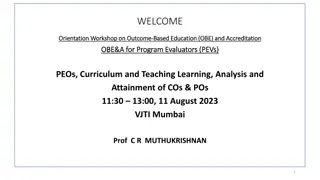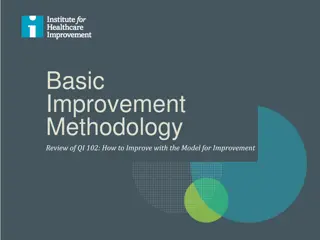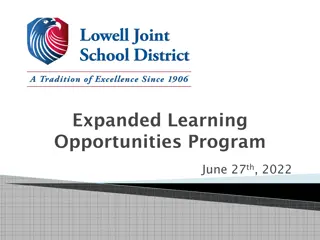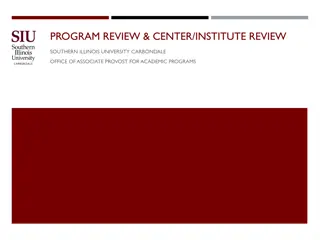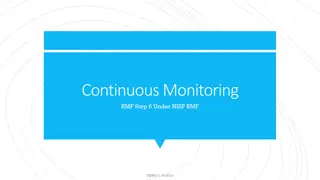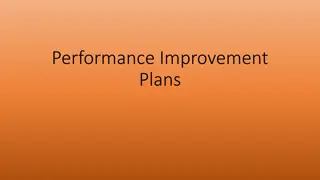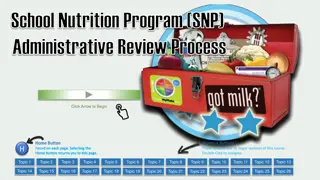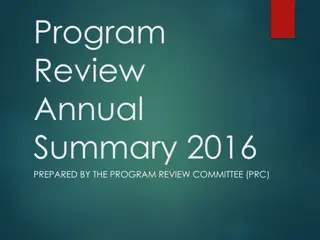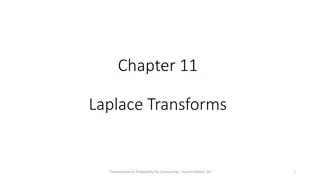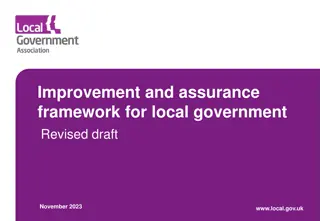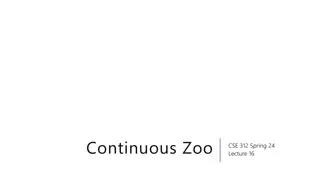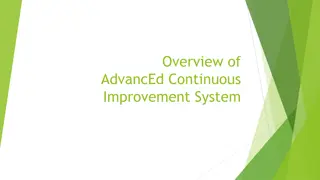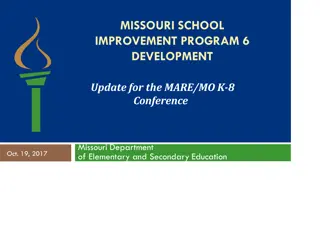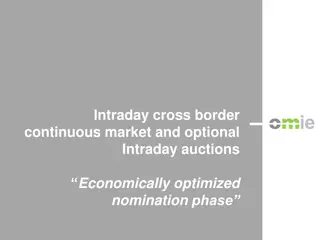Program Review Process for Continuous Improvement
The program review process is a cyclical evaluation method aimed at enhancing program quality and currency through self and peer assessment. It involves gathering data on student achievements, enrollment numbers, and feedback from external constituencies to inform improvement strategies. Regular checks on student outcomes, resources, and curriculum effectiveness are crucial for identifying areas of success and areas needing enhancement.
Download Presentation

Please find below an Image/Link to download the presentation.
The content on the website is provided AS IS for your information and personal use only. It may not be sold, licensed, or shared on other websites without obtaining consent from the author.If you encounter any issues during the download, it is possible that the publisher has removed the file from their server.
You are allowed to download the files provided on this website for personal or commercial use, subject to the condition that they are used lawfully. All files are the property of their respective owners.
The content on the website is provided AS IS for your information and personal use only. It may not be sold, licensed, or shared on other websites without obtaining consent from the author.
E N D
Presentation Transcript
Self Study Process for Continuous Program Improvement Self Study Process for Continuous Program Improvement Karin Elliott Brown October 7, 2022
Learn about Program Review process Review the Self Study template Understand how the Self Study will be evaluated. Learn about assessment, and IE resources Review strategies for inclusive participation of Self Study and five-year plan. Understand the post review process and its utility.
A program review is a cyclical process for evaluating and continuously enhancing the quality and currency of programs. The evaluation is conducted through a combination of self-evaluation, followed by peer-evaluation by external reviewers to the department and the University (external review by outside disciplinary experts). The results of the evaluation process are then used to inform follow-up planning and budgeting processes at various levels of the institution-program, department, college, university.
Your programs regular check up Gather numbers and qualitative data Who are your students?: Enrollments, majors and graduation numbers What will they know and be able to do upon graduation?: Assess quality of program and graduates through alumni surveys, student surveys and focus groups, employer data How to improve the program? Need evidence to demonstrate educational effectiveness Need evidence to support resource requests (faculty, space, staff, educational technology equipment ) Discussion of notable achievements and areas for improvement Assessment data can sometimes upset the conventional wisdom Examine the impact of changes in faculty and curriculum PR recommendations can make a difference
The Program Review Process includes, but is not limited to: Analysis of student achievement of the program s learning outcomes (PLOs) Retention and graduation rates Results of licensing exams and placement Evidence from external constituencies such as employers and professional organizations.
Year 1: The Preparation Year (this year) Year 2: The Review Year Year 3: Action Plan is approved by the Provost through a MOU. Annual report due. Post Review Years 4-5: Action Plan implementation continues along with annual reports.
Gathering data and conducting a self study Writing the self study report Developing a Five Year Plan Finding candidates to recommend as external reviewers This impacts and should involve ALL faculty members
1.0 History, Mission, Goals, and Objectives 2.0 Program Data 3.0 Curriculum and Instruction 4.0 Assessment of Program Level Outcomes 5.0 Department Faculty 6.0 Student Engagement, Outreach and Recruitment 7.0 Program Self Recommendations The Five Year Plan 1.0 History, Mission, Goals, and Objectives 2.0 Program Data 3.0 Curriculum and Instruction 4.0 Assessment of Program Level Outcomes 5.0 Department Faculty 6.0 Student Engagement, Outreach and Recruitment 7.0 Program Self Recommendations The Five Year Plan
Establish working groups that will address different sections of the Self Study. Utilize existing standing committees (e.g., the curriculum committee addresses the curriculum section, the appropriate Assessment committee addresses the PLO section, etc.). Develop a timeline for drafts to be finished.
Establishing coordination and communication mechanisms. Complete a draft of the Self Study by/before early Spring Semester. The faculty can discuss it and reflect on the data with a view toward developing the core goals of the Five-Year Plan for the program(s). Self Study report Due May 1, 2022 College Dean s must sign approval before submission
Program Review Website http://www.calstatela.edu/apra/program-review- resources Institutional Effectiveness http://www.calstatela.edu/InstitutionalEffectiveness
Progress | Stage Element Progress | Stage Element DEVELOPED (3) DEVELOPED (3) Recommendations and concerns identified in the PR self-study are partially addressed. Internal Recommendations Internal Recommendations Specific curricular changes are discussed as they are affected by emerging developments using recent supporting data. Some student factors based on trends are described. Preliminary planning in the areas of curriculum, outreach, scheduling and student retention are documented. Preliminary analysis of adequacy of resources for 5-yr period. Needs are identified based on program priorities or data. Curricular Changes Curricular Changes Student Factors (including SLOs) Student Factors (including SLOs) Resources Resources Preliminary action plan included. May include revised curriculum, timeline for task, person/committee. responsible, and cost. Action Plan and Timeline Action Plan and Timeline
These program may opt to use a modified Self Study report (MSSR). Most accreditation agencies require elements in their Self Study that are similar to those in the CSULA Self Study (and usually many that are beyond the scope of the CSULA requirements). In most cases, these programs can use the MSSR matrix (a selected portion is shown on the next slide).
External Review in Fall Semester Internal Review (Meetings, meetings, meetings, with you, the College Dean, and the PRS committee meets most of all) PRS review of self study and external reviewers report Questions Drafts of recommendations Draft of the final summary report
External reviewers selected by PRS prepare a review document that contains recommendations and commendations after visiting the Program, meeting with the Program faculty and students as well as College and University administrators. PRS examines both the self-study and the external reviewers' report. PRS meets with the program representative(s) and the College Dean(s) to forge the final summary report that contains commendations and recommendations (addressed to the program, College and University as appropriate).
The Program Chair will meet with the College Dean to discuss the report and collaboratively develop an Action Plan to implement the recommendations in the report. The action plan has roots in the Five-Year Plan and reflects the recommendations of PRS and accreditation bodies (if any). The Action Plan will specify the goals and objectives for implementation before the next review and the steps to be taken by all participants to accomplish them. Reflected in a MOU with the Provost.
Will be due in Fall Semester. The annual report is important for several reasons. It will be a piece of your next Self Study, both as an appendix and summarized in your assessment section. It is an odometer reading on your progress in accomplishing the goals the program set in its action plan (are we there yet?). It facilitates annual meetings with your College Dean to support continuous program improvement.


